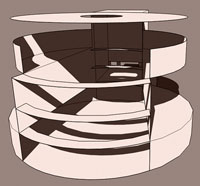Some Like It Radiant
An Isolated System
Energy efficiency was a priority in the planning and design of the new corporate headquarters for the National Rural Utilities Cooperative Finance Corporation (NRUCFC) in Loudon County, Va. After all, explains Tsutomu Ben Kishimoto, AIA, of the Rosslyn, Virginia-based architecture firm Kishimoto.Gordon.Dalaya (KGD), the organization is "in the energy business and very conscious about being a leader in energy efficiency."
To this end, NRUCFC fully supported an integrated design process. Early on, for example, representatives from the client organization and the design and construction firms met every few weeks to consider a variety of innovative systems. A lot of ideas got tossed out, but radiant heating and cooling coupled with a geothermal system for the atrium survived the vetting process.
The three-story atrium, which faces an exterior courtyard to the west, is wrapped by offices on the other three sides. Its circular floor is almost 8,000 square feet, or about 6 percent of the building's total usable floor area. Now in construction, the project is expected to be completed by fall 2011.
The atrium's radiant heating and cooling system consists of multiple loops of PEX tubing sandwiched between R-12 closed cell insulation and a 6-inch concrete slab below and a 2-inch topping slab of concrete and granite pavers above. The ribbons of tubing circle to and from manifolds that are connected to a circulation pump. This pump directs water returning from the atrium floor to a heat exchanger to either absorb heat from or release heat to a closed loop geothermal system before returning back to the manifolds and spreading out again through the floor.
The temperature range of the atrium floor is from 68 to 80 degrees Fahrenheit- a span of only 12 degrees between full cooling and full heating. "The radiant system is so effective because we have such a large space to work with," says Daniel Nall, FAIA, PE, director of sustainability at WSP Flack + Kurtz in New York.
 |
 |
Left: A rendering of the interior atrium at NRUCFC facing west toward the entry. Top: A shadow study of the summer sun (high in the sky) setting in the west (facing the atrium). Illustrations: KGD Architecture (left); WSP Flack + Kurtz (top) |
Â
Two water-to-air heat pumps, which also take advantage of the geothermal water loop, provide ventilation and humidity control throughout the space. For example, to prevent moisture from pooling on the floor in the summer, air diffusers blow cool, dry air toward any hot, moist air that enters when the courtyard doors are opened. The engineers also eliminated cooling tubes in the floor within 1 foot of the doorway.
The geothermal system was built for the atrium only: the rest of the building is heated and cooled with variable air volume (VAV) boxes and air ducts running from a conventional central plant. Taken together, the many energy-saving strategies throughout the building are predicted to reduce energy consumption by 32.7 percent as compared to a base case building adhering to the minimum requirements of ASHRAE 90.1-2004.









